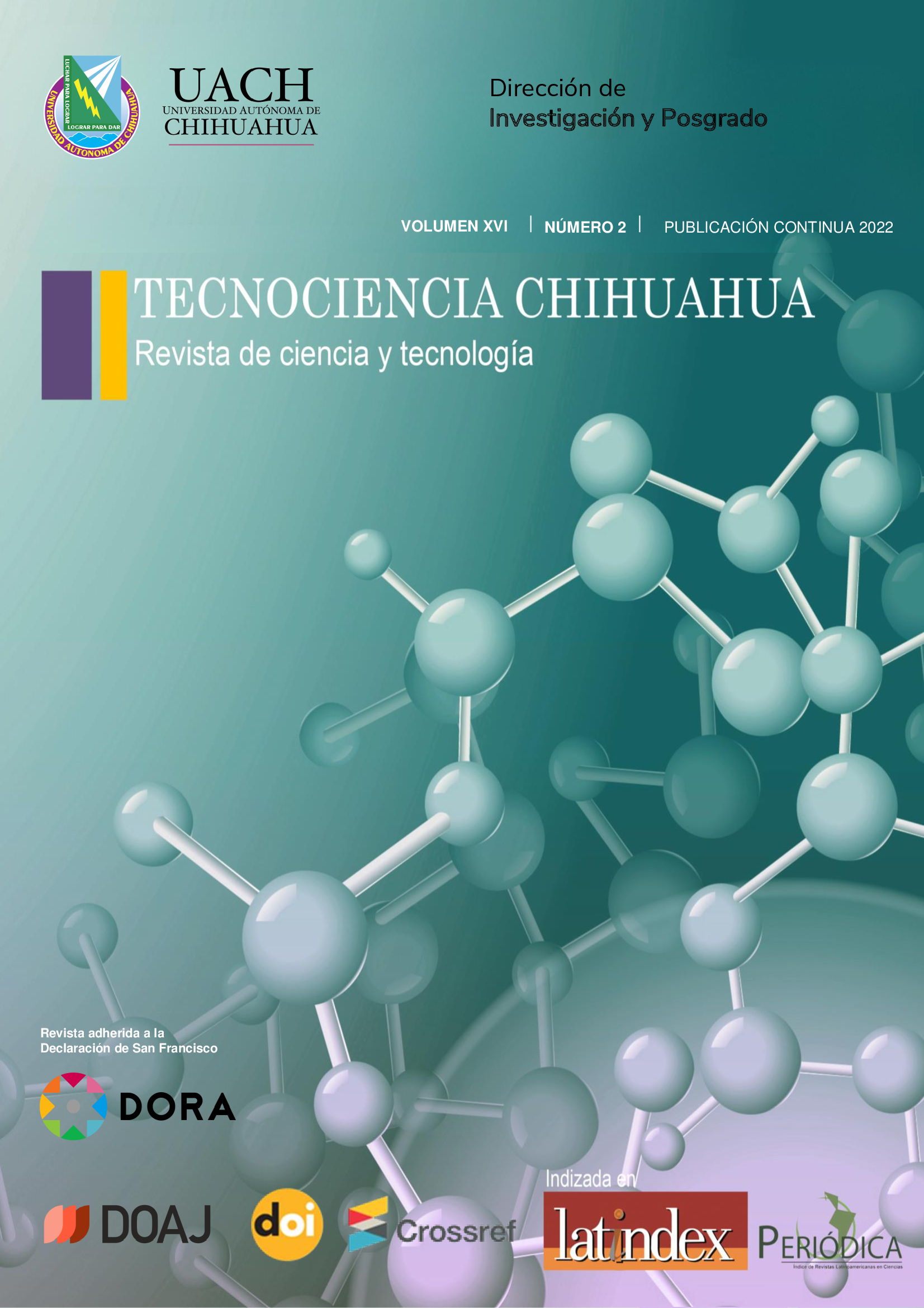Uso de imágenes captadas mediante UAV para estimar el estado general de huertas citrícolas
Use of UAV imagery to estimate the topography, morphostructure and health status of citrus orchards
Resumen
Los vehículos aéreos no tripulados (UAV), permiten monitorear de manera constante variables de importancia para la producción agrícola. Es por ello que su uso es deseable. Por lo tanto, el objetivo del estudio fue estimar la topografía, las características morfoestructurales y el estado de salud de los árboles en dos huertas citrícolas mediante imágenes captadas UAV. Se realizó fotogrametría y se determinó la altura individual de árboles, diámetro de copa, número de árboles, geolocalización de árboles faltantes, identificación de árboles de otra especie y la salud de la huerta mediante el Índice de Vegetación de Diferencia Normalizada (NDVI). De acuerdo con los resultados, es posible identificar y geolocalizar el número de árboles, conocer el marco real de plantación, y determinar la altura de árboles 70 % más rápido en comparación con el método aleatorio. La altura promedio de árbol fue de 3 y 4 m, en la huerta 1 y 2 respectivamente. El NDVI en las huertas oscilo entre 0.18 a 0.95, encontrándose los valores mayores en la huerta 2. La información obtenida puede ser utilizada por productores para subsanar fallas de forma dirigida, y por las aseguradoras para la renovación y estimar los costos de las pólizas de seguro.
Citas
Abdulridha, J., Ehsani, R., Abd-Elrahman, A., Ampatzidis, Y. 2018. A remote sensing technique for detecting laurel wilt disease in avocado in presence of other biotic and abiotic stresses. Computers and Electronics in Agriculture, 156: 549-557. https://doi.org/10.1016/j.compag.2018.12.018
Ampatzidis, Y., Partel, V. 2019. UAV-Based High Throughput Phenotyping in Citrus Utilizing Multispectral Imaging and Artificial Intelligence. Remote Sensing, 11 (410): 2-19. https://doi.org/10.3390/rs11040410
Ampatzidis, Y., Partel, V., Costa, L. 2020. Agroview: Cloud-based application to process, analyze and visualize UAVcollected data for precision agriculture applications utilizing artificial intelligence. Computers and Electronics in Agriculture, 174 105457: 1-12. https://doi.org/10.1016/j.compag.2020.105457
Costa, L., Nunes, L., Ampatzidis, Y. 2020. A new visible band index (vNDVI) for estimating NDVI values on RGB images utilizing genetic algorithms. Computers and Electronics in Agriculture, 172: 1-13. https://doi.org/10.1016/j.compag.2020.105334
Csillik, O., Cherbini, J., Johnson, R., Lyons, A., Kelly, M. 2018. Identification of Citrus Trees from Unmanned Aerial Vehicle Imagery Using Convolutional Neural Networks. Drones, 2 (4): 1-16. https://doi.org/10.3390/drones2040039
Delavarpour, N., Koparan, C., Nowatzki, J., Bajwa, S., Sun, X. 2021. A Technical Study on UAV Characteristics for Precision Agriculture Applications and Associated Practical Challenges. Remote Sensing, 13: 1-25. https://doi.org/10.3390/rs13061204
Delgado, G., Estrada, J., Rivera, M., Catalán, E., Esquivel, G. 2014. Evaluación y diseño del riego por melgas mediante un modelo de simulasión. AGROFAZ, 14(2): 45-51. https://dialnet.unirioja.es/servlet/articulo?codigo=5733354
Demin, P.E. 2014. Aportes para el mejoramiento del manejo de los sistemas de riego. Instituto Nacional de Tecnología Agropecuaria. San Fernando del Valle de Catamarca, Catamarca. pp 28. https://bit.ly/3SkIkO9
González, A., Amarillo, G., Amarillo, M., Sarmiento, F. 2016. Drones aplicados a la agricultura de precisión. Revista Especializada en Ingeniería, 10: 23-37. https://doi.org/10.22490/25394088.1585
Ha, T., Duddu, H., Vandenberg, A., Shirtliffe, S. 2022. A semi-automatic workflow for plot boundary extraction of irregularly sized and spaced field plots from UAV imagery. The Plant Phenome 2022; 5:e20039: 1-8. https://doi.org/10.1002/ppj2.20039
Hashimoto, N., Saito, Y., Maki, M., Homma, K. 2019. Simulation of Reflectance and Vegetation Indices for Unmanned Aerial Vehicle (UAV) Monitoring of Paddy Fields. remote sensing, 11 (2119): 2-13. https://doi.org/10.3390/rs11182119
Houborg, R., y Boegh, E. 2008. Mapping leaf chlorophyll and leaf area index using inverse and forward canopy reflectance modeling and SPOT reflectance data. Remote Sensing of Environment, 112: 186–202. https://doi.org/10.1016/j.rse.2007.04.012
Huete, A., Didan, K., Miura, T., Rodríguez, E.P., Gao, X., Ferreira, L.G. 2002. Overview of the radiometric and biophysical performance of the MODIS vegetation indices. Remote Sensing of Environment, 83 (1): 195-213. https://doi.org/10.1016/S0034-4257(02)00096-2
Kameyama, S., Sugiura, K. 2020. Estimating Tree Height and Volume Using Unmanned Aerial Vehicle Photography and SfM Technology, with Verification of Result Accuracy. 4 (19): 1-21. https://doi.org/10.3390/drones4020019
Lemenkova, P. 2020. Object Based Image Segmentation Algorithm of SAGA GIS for Detecting Urban Spaces in Yaoundé, Cameroon. Central European Journal of Geography and Sustainable Development, 2 (2), 38-51. https://doi.org/47246/CEJGSD.2020.2.2.4
Maimaitijiang, M., Sagan, V., Sidike, P., Hartling, S., Esposito, F., Fritschi, F.B. 2020. Soybean yield prediction from UAV using multimodal data fusion and deep learning. Remote Sensing of Environment, 237-111599: 1-20. https://doi.org/10.1016/j.rse.2019.111599
Nasiri, V., Darvishsefat, A.A., Arefi, H., Pierrot, M., Namiranian, M., Le Bris, A. 2021. Unmanned aerial vehicles (UAV)-based canopy height modeling under leaf-on and leaf-off conditions for determining tree height and crown diameter (case study: Hyrcanian mixed forest). Can. J. For. Res, 51: 926-971. https://dx.doi.org/10.1139/cjfr-2020-0125
Pino, E. 2019. Los drones una herramienta para una agricultura eficiente: un futuro de alta tecnología. IDESIA (Chile), 37 (1): 75-84. http://dx.doi.org/10.4067/S0718-34292019005000402
Ramos, C., Delgado, G., Catalán, E., Rivera, M., Almeyda, I. 2018. Eficiencia agronómica del riego localizado: caso de estudio en region citrícola de Nuevo León. AGROFAZ, Esp. 103-112.
Sagan, V., Maimaitijiang, M., Sidike, P., Eblimit, K., Peterson, K.T., Hartling, S., Esposito, F., Khanal, K., Newcomb, M., Pauli, D., Ward, R., Fritschi, F., Shakoor, N., Mockler, T. 2019. UAV-Based High Resolution Thermal Imaging for Vegetation Monitoring, and Plant Phenotyping Using ICI 8640 P, FLIR Vue Pro R 640, and thermoMap Cameras. Remote Sensing, 11(3): 330. https://doi.org/10.3390/rs11030330
Torres, J., López, F., Serrano, N., Arquero, O., Peña, J. 2015. High-Throughput 3-D Monitoring of Agricultural-Tree Plantations with Unmanned Aerial Vehicle (UAV) Technology. PLOS ONE, 10 (6): 1-20. https://doi.org/10.1371/journal.pone.0130479
Volpato, L., Dobbels, A., Borem, A., Lorenz, A.J. 2021. Optimization of temporal UAS-based imagery analysis to estimate plant maturity date for soybean breeding. The Plant Phenome J., 2021; 4:e20018: 1-15. https://doi.org/10.1002/ppj2.20018
Zeng, L., Peng, G., Meng, R., Man, J., Li, W., Xu, B., Lv, Z., Sun, R. 2021. Wheat Yield Prediction Based on Unmanned Aerial Vehicles-Collected Red–Green–Blue Imagery. Remote Sensing, 13(2937): 1-19. https://doi.org/10.3390/rs13152937
Derechos de autor 2022 TECNOCIENCIA Chihuahua

Esta obra está bajo licencia internacional Creative Commons Reconocimiento-NoComercial 4.0.









